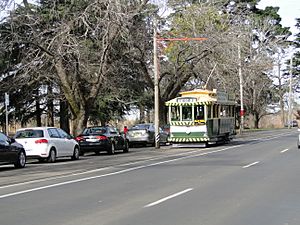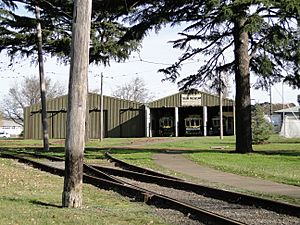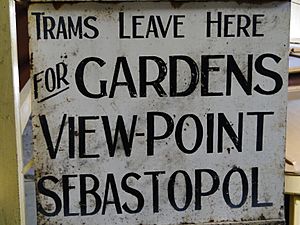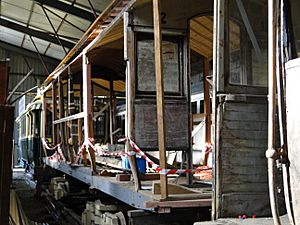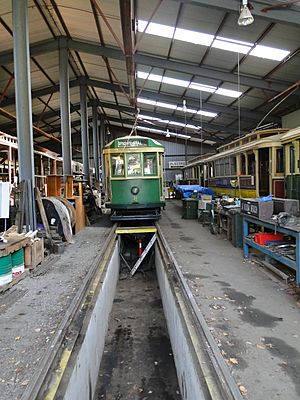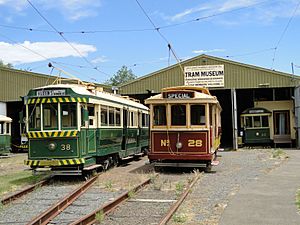Ballarat Tramway Museum facts for kids
| Established | 1971 |
|---|---|
| Location | Ballarat, Victoria, Australia |
The Ballarat Tramway Museum is a special place in Ballarat, Victoria, Australia, where old trams come to life! It's run by amazing volunteers who love trams. They have many old trams that still run on a part of the original tram tracks. These tracks go around Lake Wendouree and through the beautiful Botanical Gardens.
The museum also keeps a huge collection of information and items about Ballarat's tram history. Trams were a big part of Ballarat's transport. They ran on a large network across the city from 1887 until 1971.
Contents
Saving Ballarat's Trams
In May 1971, a group of people started working to save a part of the old tramway. They talked with the State Electricity Commission of Victoria (SEC), which used to run the trams. Another group, the Ballarat Tramway Preservation Society, also formed in 1971. Their goal was to create a real working tramway museum.
Over the years, the society changed its name a few times. It became the Ballarat Tourist Tramway in 1978. Then, in 1981, it was called the Ballarat Vintage Tramway. Finally, in 1995, it became the Ballarat Tram Museum Inc.
Keeping the Tracks Alive
The first idea was to save all the tram tracks around Lake Wendouree. But after talking with the SEC and the City of Ballarat, they decided to keep only the section of track in the Botanical Gardens. This part was special because it included some of the very first horse tram tracks from 1887. These tracks were later changed to electric in 1905. The SEC helped by giving the museum equipment, tracks, overhead wires, and even some trams.
Building a New Home for Trams
The original tram depot (where trams were stored) was sold in 1972. So, a new home was needed! The City of Ballarat gave land in the South Gardens Reserve for a new depot. Six Ballarat trams that were stored in the old depot had to be moved. They were towed around Lake Wendouree to the new site. Workers laid a special track to get them there. Then, the trams were carefully pulled into the new shed using a hand winch.
In July 1974, a new power station was built to give electricity to the trams. On October 12, 1974, Tram No. 27 made its first few trips on the new access track. During November and December 1974, more track was laid to connect the new depot to the existing tram tracks on Wendouree Parade. This was a tricky job because the rails had to be bent into curves.
First Rides and Grand Opening
The very first trip on the museum's tramway happened on December 7, 1974. Tram No. 27 tested the connection to the main tramway. Then, Tram No. 40 was taken out of the depot and driven along the entire track. Tram No. 40 was special because it was the last tram to run on the SEC network before it closed.
Passengers rode the trams for the first time on December 24, 1974. Regular services began just two days later, on December 26. The tramway was officially opened on February 1, 1975.
In 2022, a new display building opened. This building lets the museum show off many trams. It also has information boards and interactive screens for visitors to learn more.
The Tram Fleet
In 1971, the SEC gave the museum five trams. The City of Ballarat also gave one tram to the museum. Since then, the museum has found and brought back many other old Ballarat trams.
One tram had been on display in a park for 10 years. The museum worked hard to restore it so it could run again. An original horse tram was found being used as a sleepout (a small room) in Ballarat! After a lot of rebuilding, they discovered it was the very first Number One tram from 1887. Now, it's used for special events. The museum also has two large W class trams from Melbourne.
Meet the Trams
Here are some of the amazing trams at the museum:
- Number 1: Built in 1887, this was one of the first horse trams made for Ballarat. It was almost completely rebuilt after being found in 1985. It started running again in 1992 and is used a few times a year with horses!
- Geelong Number 2: Built in 1912, this is the only one of its kind still around. It came from Geelong.
- Number 8: Built in 1934, this tram was used to clean tracks in Melbourne. It came to Ballarat in 1999 and still helps clean the tracks today.
- Number 11: Built in 1915, this tram had a long journey. It was used in Melbourne, then Geelong, and finally came to Ballarat in 1936. It was given to a museum in Daylesford in 1971 and returned to Ballarat in 1977. It is currently in storage.
- Number 12: Built in 1892 as a cable car trailer in Sydney. It came to Ballarat in 1905 and was changed into an electric tram. It was later used as a room in a house! Found in 1990, it is now being restored.
- Number 13: Built in 1915, this tram also worked in Melbourne and Geelong before coming to Ballarat in 1936. It was given to another society in 1971 and returned to Ballarat in 1983.
- Number 14: Built in 1915, this tram also worked in Melbourne and Geelong before coming to Ballarat in 1936. The City of Ballarat owns this tram.
- Number 18: Built in 1913, this tram worked in Melbourne before coming to Ballarat in 1931. It traveled over 748,000 miles in Ballarat! In 1971, it was put on display in a park. The museum restored it in 1982, and it now runs regularly. It's painted in its 1960s colors.
- Number 21: Built in 1913 in Ballarat. It was sold in 1935 to be used in a house and returned to Ballarat in 1994. It is in poor condition and used for parts.
- Number 22: Another tram built in Ballarat in 1913. It was also sold in 1935 for use in a house and returned to the museum in 2009. Some restoration work has been done, but it is in storage.
- Number 26: Built in 1916, this tram came to Ballarat in 1930. It traveled over 1 million miles around Ballarat! This was the first tram at the museum to carry passengers on December 24, 1974.
- Number 27: Built in 1916, this tram came to Ballarat in 1930. It traveled almost 1 million miles. It was badly damaged in a crash in 1963. It is painted in its 1935 colors.
- Number 28: Built in 1916, this tram came to Ballarat in 1930. It traveled over 1 million miles around Ballarat! It was one of the six trams given to the museum by the SEC. It needed major repairs and has been restored twice. It is painted in 1930s colors. This tram is currently stored offsite.
- Number 32: Built in 1917, this tram came to Ballarat in 1935. It was sold to a wildlife park in 1971 and returned to Ballarat in 1986. It is currently on display in the museum's building.
- Number 33: Built in 1917, this tram also came to Ballarat in 1935. It was sold to a museum in Hamilton in 1971 and returned to Ballarat in 1977.
- Number 38: Built in 1914, this tram came to Ballarat in 1951. It traveled over 347,000 miles in Ballarat.
- Number 39: Built in 1914, this tram came to Ballarat in 1951. It traveled over 375,000 miles. It was sold to a Lions Club in 1971 and used for display in a park. It returned to Ballarat in 1977 and was turned into a museum display area and shop.
- Number 40: Built in 1913, this tram came to Ballarat in 1951. It traveled over 376,000 miles in Ballarat. This was the very last tram to run on the Ballarat tramway network. It was also the first tram to run on the Ballarat Tramway Museum tracks!
Trams from Melbourne
The museum also has trams that did not originally run in Ballarat, but came from Melbourne:
- Number 407: A W2 Class tram that started service in Melbourne in 1926.
- Victorian Railways Number 41: This tram started service in Melbourne in 1923 and only ran on the St. Kilda – Brighton Beach line. After the tramways closed, it was used as a tool shed! It has been restored to its original look.
- Number 661: A W3 class tram built between 1930 and 1934. It was brought to Ballarat in 1976. This tram was badly damaged in a crash in 2019 and is now in storage.
- Number 671: A W4 class tram built between 1933 and 1935. These were the first wider trams. It was brought to Ballarat in 1976.
- Number 924: A Melbourne SW6 class tram, currently in storage. It started service in 1946.
- Number 939: A Melbourne SW6 class tram that started service in 1948. It was later changed into a special restaurant tram called "Valentine" in Melbourne. The museum bought it in 2013. After 18 months of restoration, it started running again in April 2016 as a cafe and special event tram, named "Cuthberts 939".
- Number 1029: A Melbourne W7 class tram that started service in 1956. It started running again at the museum in November 2023.
- Number 1039: A Melbourne W7 class tram that started service in 1956. It is currently in storage off site.
The Ballarat Tramway Museum also has a 1952 Bedford truck. This truck has a tall tower to reach the overhead wires. It was first used in Sydney and came to Ballarat in 1961. The truck is on display in the museum's building.
More to Explore
- Trams in Ballarat
- Trams in Geelong


